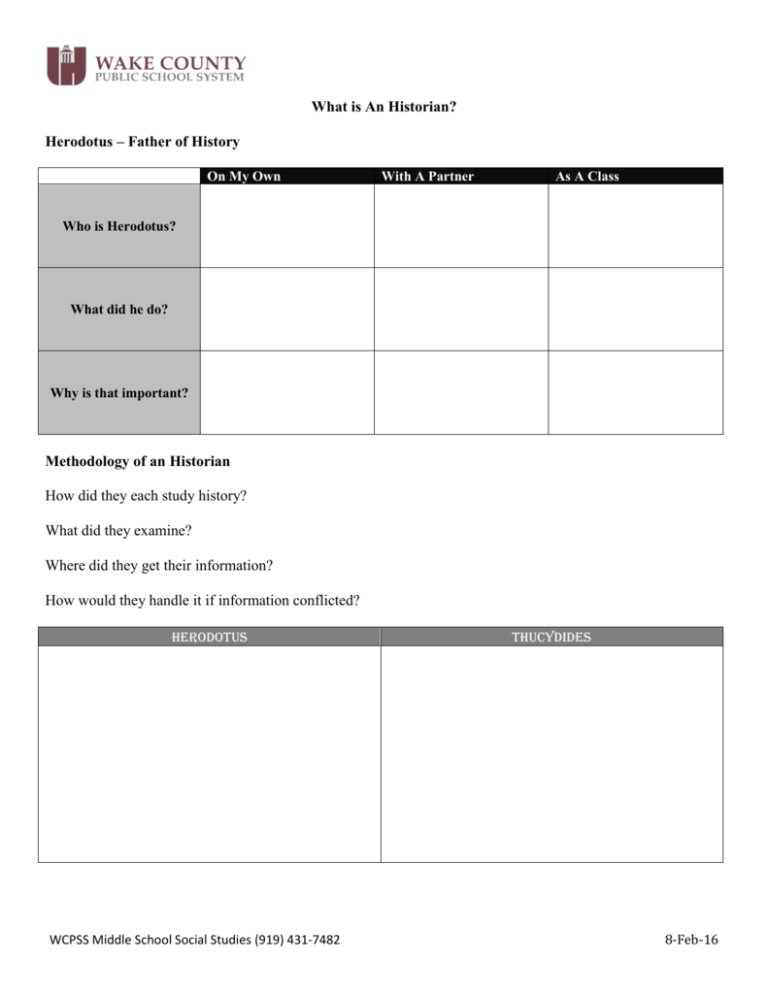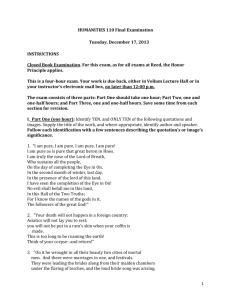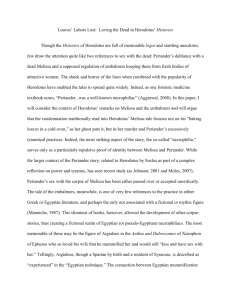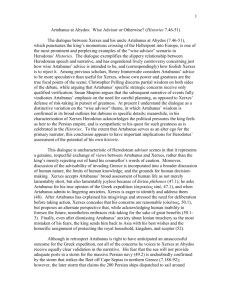Herodotus - jejordan3
advertisement

What is An Historian? Herodotus – Father of History On My Own With A Partner As A Class Who is Herodotus? What did he do? Why is that important? Methodology of an Historian How did they each study history? What did they examine? Where did they get their information? How would they handle it if information conflicted? Herodotus WCPSS Middle School Social Studies (919) 431-7482 Thucydides 8-Feb-16 Which Version is Better? Herodotus: How were the pyramids built? Draw an image Diodorus Siculus: How were the pyramids built? Draw an image Professor Redford: How were the pyramids built? WCPSS Middle School Social Studies (919) 431-7482 Draw an image 8-Feb-16 Herodotus – Father of History Ἡροδότου Ἁλικαρνησσέος ἱστορίης ἀπόδεξις ἥδε, ὡς μήτε τὰ γενόμενα ἐξ ἀνθρώπων τῷ χρόνῳ ἐξίτηλα γένηται, μήτε ἔργα μεγάλα τε καὶ θωμαστά, τὰ μὲν Ἕλλησι, τὰ δὲ βαρβάροισι ἀποδεχθέντα, ἀκλεᾶ γένηται, τὰ τε ἄλλα καὶ δι' ἣν αἰτίην ἐπολέμησαν ἀλλήλοισι. Translation: Herodotus of Halicarnassus, his Researches are here set down to preserve the memory of the past by putting on record the astonishing achievements both of our own and of other peoples; and more particularly, to show how they came into conflict. WCPSS Middle School Social Studies (919) 431-7482 8-Feb-16 Methodology of an Historian Herodotus The Greek writer Herodotus is considered the world's first historian, "the father of history." Others have called him "the father of lies." Herodotus explored centuries of contacts between the ancient Greeks and the Persian Empire, culminating in the Persian Wars of the early fifth century B.C. In dramatic land and sea battles, the Greeks managed to repel invaders from the much larger, richer, and more powerful Persian Empire to the east. Later historians have said these Greek victories saved Western Civilization. To compile his history, Herodotus relied on oral accounts and he included gossip, myths, and rumors. Sometimes he would provide conflicting accounts of events and invite the reader to decide which to believe. Herodotus wrote, "No one is so foolish as to prefer war to peace: in peace children bury their fathers, while in war fathers bury their children." Historians are undocumented elsewhere in the world until the first century B.C. in China. _____________________ © 2001 - 2011 michael g. maxwell - maxwell learning l.l.c. WCPSS Middle School Social Studies (919) 431-7482 Thucydides The Greek writer Thucydides (thoo-SID-uhdees) is credited with writing the first "scientific" history. Gods and legends played no role in his history of the Pellopenesian War between Athens and Sparta, which took place in the late fifth century B.C. After 27 years of conflict, Sparta won and Athens went into decline. Thucydides wrote only about events that occurred during his lifetime that he could verify through examination of written records and eyewitness accounts. He strived for complete objectivity, and in this way he pioneered the historical method used by historians today. Thucydides wrote, "So adverse to taking pains are most men in the search for the truth, and so prone are they to turn to what lies readily at hand." He said truth could be distinguished from fiction "only after investigating with the greatest possible accuracy each detail." He tried not only to recount events, but to make sense of them. Thucydides records one of his figures as observing that men go to war out of "honor, fear, and interest," a formulation not improved upon in subsequent centuries. He determined that war could be avoided if humans would base their choices on reason rather than force. According to Thucydides, it was because the Athenians violated this principle that they eventually suffered defeat. 8-Feb-16 Which Version is Better? Herodotus explains how the pyramids were built: This pyramid was made like stairs, which some call steps and others, tiers. When this, its first form, was completed, the workmen used short wooden logs as levers to raise the rest of the stones; they heaved up the blocks from the ground onto the first tier of steps; when the stone had been raised, it was set on another lever that stood on the first tier, and the lever again used to lift it from this tier to the next. It may be that there was a new lever on each tier of steps, or perhaps there was only one lever, quite portable, which they carried up to each tier in turn; I leave this uncertain, as both possibilities were mentioned. But this is certain, that the upper part of the pyramid was finished off first, then the next below it, and last of all the base and the lowest part. Hundreds of years later Diodorus Siculus wrote this account of how the pyramids were built: And 'tis said the stone was transported a great distance from Arabia, and that the edifices were raised by means of earthen ramps, since machines for lifting had not yet been invented in those days; and most surprising it is, that although such large structures were raised in an area surrounded by sand, no trace remains of either ramps or the dressing of the stones, so that it seems not the result of the patient labor of men, but rather as if the whole complex were set down entire upon the surrounding sand by some god. Now Egyptians try to make a marvel of these things, alleging that the ramps were made of salt and natron and that, when the river was turned against them, it melted them clean away and obliterated their every trace without the use of human labor. But in truth, it most certainly was not done this way! Rather, the same multitude of workmen who raised the mounds returned the entire mass again to its original place; for they say that three hundred and sixty thousand men were constantly employed in the prosecution of their work, yet the entire edifice was hardly finished at the end of twenty years. WCPSS Middle School Social Studies (919) 431-7482 8-Feb-16 How Were The Egyptian Pyramids Built? ScienceDaily (Mar. 28, 2008) http://www.sciencedaily.com/releases/2008/03/080328104302.htm The ancient Egyptians probably chose that distinctive form for their pharaohs' tombs because of their solar religion, explained Donald Redford, professor of Classics and ancient Mediterranean studies at Penn State. The Egyptian sun god Ra, considered the father of all pharaohs, was said to have created himself from a pyramid-shaped mound of earth before creating all other gods. The pyramid's shape is thought to have symbolized the sun's rays. … Said Redford, the image most people have of slaves being forced to build the pyramids against their will is incorrect. "The concept of slavery is a very complicated problem in ancient Egypt," he noted, "because the legal aspects of indentured servitude and slavery were very complicated." The peasants who worked on the pyramids were given tax breaks and were taken to 'pyramid cities' where they were given shelter, food and clothing, he noted. … Teams of oxen or manpower were used to drag the stones on a prepared slipway that was lubricated with oil. Said Redford, a scene from a 19th century B.C. tomb in Middle Egypt depicts "an alabaster statue 20 feet high pulled by 173 men on four ropes with a man lubricating the slipway as the pulling went on." Once the stones were at the construction site, ramps were built to get them into place on the pyramid, said Redford. These ramps were made of mud brick and coated with chips of plaster to harden the surface. "If they consistently raised the ramp course by course as the teams dragged their blocks up, they could have gotten them into place fairly easily," he noted. At least one such ramp still exists, he said. When answering to skepticism about how such heavy stones could have been moved without machinery, Redford says, "I usually show the skeptic a picture of 20 of my workers at an archaeological dig site pulling up a two-and-a-half ton granite block." He added, "I know it's possible because I was on the ropes too." WCPSS Middle School Social Studies (919) 431-7482 8-Feb-16











